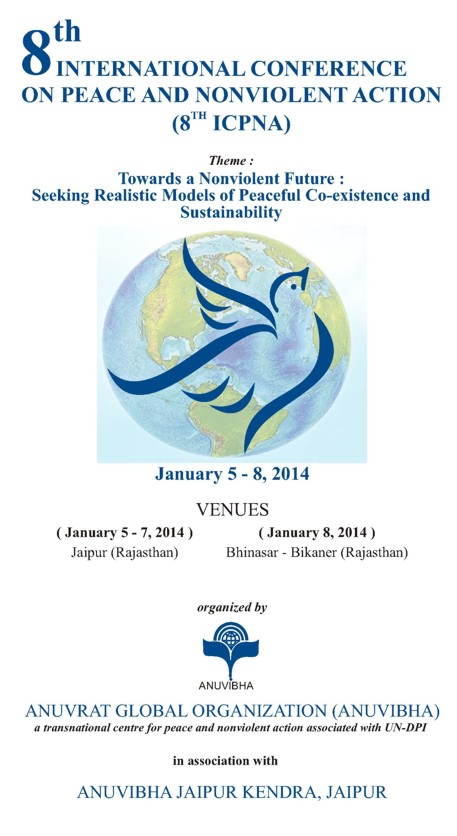 | 8th International Conference on Peace and Nonviolent Action |
Dealing With Emotions For A Better World
Namaskar,
We are grateful and happy to be here with you all. The theme of this conference is how to live together on this planet in a nonviolent lifestyle. This theme can be discussed from numerous angles and on many levels. We discuss this theme looking at how people can deal with their emotions, integrating knowledge from East and West.
There are positive emotions and there are negative emotions. This lecture is about negative emotions. So when we use the word ‘emotion’ in this lecture, we refer to negative emotions only, for example pain, sadness, anger, fear, guilt, greed, lust, sadness, jealousy, hatred, and so on. These feelings are a part of all of us. We all have to deal with them.
Many ways of dealing with negative emotions however have a negative impact on the person who is feeling these emotions and on his environment. Let me explain what I mean by this.
Obviously emotions can have a negative effect on the person who is experiencing or suppressing the emotion and it can have a negative effect on his environment. This environment can be the family; the community he is living in; the people he is responsible for in his work, be it a few people, a nation or the entire world.
Let us have closer look at some characteristics of emotions and emotional behavior.
- Emotion as a limited state of consciousnessConsciousness ranges from utter darkness to supreme light. The emotions we are dealing with in this lecture are more dark than light. They are a limited range of consciousness. If we would look at them in terms of Tamas, Rajas and Sattva, they would be qualified as tamasic and rajasic.
- The impact of emotional behaviorThe impact of emotional behavior on others is much bigger than we usually realize. It can for example lead to other people feeling hurt or not understood; these people are likely to close their heart, instead of feeling encouraged to open their heart. The result often is a spiraling down of the quality of energy. Negative emotions will be empowered, instead of weakened. People could tend to be submissive out of fear instead of co-productive out of love.
- Identification vs de-identificationTake a man who is very angry and is scolding his wife because she broke a teacup. All his anger is coming out on her. He believes he is in the position to do so, because of the action of his wife. She broke the cup! We say this man is identified with his emotion. This is a very important concept. He does not realize that his emotion is a limited state of consciousness. For him, this state is all there is. What we need is de-identification: realizing that this emotion is just a limited, lower state of consciousness that one does not want to act upon; shifting consciousness from the emotional level to a higher level of consciousness. At that point, you no longer are the emotion, but witness the emotion.
Let’s see what this would look like in our example.
There is the woman who breaks the tea cup. There is her husband who feels his anger coming up. He realizes this will bring him into an emotional state, leading him to harm his wife, the children as witnesses and by law of karma, himself. He chooses to shift from this emotional state into his higher consciousness. He then realizes how good willing his wife is. ‘Did the hot tea hurt you?’, he asks her? ‘Let me help you clear it up’.
In this example we see that a state of consciousness leads to specific thoughts, feelings and actions. While being identified with his anger he was about to beat his wife. When he shifted his consciousness he cared for his wife and helped her. The first would create a distance between this man and his wife, the second opened up their love for each other.
Responsibility
Who is responsible for the man scolding the wife who broke the cup? On the emotional level the man thinks his wife is responsible: she was the one that broke the cup. On a higher level of consciousness he realizes he himself is responsible and chooses to step out of his emotional layer.
We have trained many people in groups and individually in dealing with their emotions. We found that most of our trainees were fully identified with their emotional layer. They even were not aware that there is another layer of consciousness. Once they started to learn they could shift from their emotional state into another state of consciousness, they started to realize that they themselves were responsible for their words and deeds in their emotional state. Many of these trainees experienced this as an enormous break-through.
- It concerns us all
We have to face that this does not only concern the other. It concerns all of us. We all can learn and improve ourselves at this level.
We summarize:
Emotional feelings, thoughts and behavior are a limited state of consciousness. These emotional words, thoughts and actions are harmful for the environment. People in this limited state of consciousness usually do not realize how harmful their words and actions are. On top of that, they usually hold the other responsible for their behavior. To stop this, people need to understand how harmful their words and actions are and they need to understand and experience that their emotional state is no more than a very limited state of their consciousness. How can we achieve this? Let us first look at the family.
The family is the place where a child learns how to deal with his emotions. Here he can learn what the impact is of expressing negative emotions towards others. Facing the fact that he can hurt other people with the expression of his emotions is not easy for a child. What is needed for this first of all is unconditional love. This gives a child the courage to see himself. And then of course it is important that a parent talks (about this) with the child. Because it is through communication that a child can learn what the impact is of his deeds on others and how he can restore the imbalance that he created by his emotional expression. This training should start at a very young age and be continued all the time the child is growing up. It will teach him to be responsible for his emotions. This approach is very different from general practice in many families, where punishment is carried out by withdrawing love, in the mistaken belief that that is the only way to teach a child how to behave well. Is the withdrawing of love not an act of violence itself?
Teaching a child that he or she is responsible for his emotional behavior is important, but not enough. The child should also be taught techniques how to deal with its emotions. These techniques can be taught not only to children, but to any person of any age.
Let us have a look at what we expect from an effective way to deal with emotions and how this can be achieved.
- It should be available to any person in the world, any time and of course for free.
- It should help us to de-identify with our emotional layer of consciousness.
- It should transform emotions and emotional energy effectively and easily.
- Or it should help us to shift from the emotional layer of our consciousness into our higher consciousness.
We work with 3 different techniques that meet all these standards. We describe these techniques to you briefly.
Transforming emotional energy
We call the first technique transforming emotional energy.
It’s main ingredients are the correct breathing and the right focus of attention.
The right breathing helps us to step out of our emotional layer. We no longer are the emotion, but we witness the emotion. Essentially it means breathing out twice as long as in, preferably 3 seconds in and 6 seconds out. Correct breathing also means breathing in the lower belly. This activates the body organs and the lower chakra’s to transform emotional energy. With the right focus we mean mindfully being aware of the strongest emotion or body sensation that is related to the particular emotion at that moment. So the body needs three things to be able to transform emotions:
- Breathing in the lower belly.
- Breathing out twice as long as in, preferably 3 seconds in and 6 out.
- Mindfully feeling the emotion or body related sensation.
In this way the body will generally very quickly - often within a minute - transform an emotion. Once this layer is transformed, often another layer pops up, which you work through in the same way. In this way, layer after layer is transformed, until you connect again with your higher consciousness. Doing this is relatively easy because this pranayama, this breathing technique, helps you to witness your emotion. The emotion therefore does not feel so raw anymore.
Going through the layers
The second technique we call going through the layers.
Once you master the first technique, you realize more and more that the emotion that you feel is no more than a limited state of your consciousness. Then you are ready to learn the second technique. In this second technique you breathe in the same way as in the first technique, so that you can easily de-identify with the emotion that you experience. You feel the first layer, accept it as what it is. Then choose not to stay in this limited state of consciousness, but just move on to layer that is beneath this first layer. Let’s say that your first layer is anger, while the second layer could be the feeling being excluded by your friends. This way you go through all the layers. Ideally you reach being in contact with your higher self, one’s true nature, which one can feel as inner peace, quietude, feeling supported, etc. This technique teaches you very clearly the difference in quality between the emotional layer and the higher self.
Straight shifting
The third technique we call straight shifting.
With shifting we mean that you go from your emotional state of consciousness into the consciousness of your higher self. We call this straight shifting, because we do it in one go and not, like the other techniques, layer by layer. This is the most advanced technique. Once you master this, you can by an act of will shift your awareness from your emotional self directly into your higher self.
People who meditate regularly, like doing Preksha, generally learn these techniques more quickly, because they are used to work with pranayamas and their state of consciousness is generally more developed. People who do yoga generally have a more open body structure. This also helps in mastering these techniques.
These are three techniques we work with and that we teach people. The first of these techniques is described in detail in a text that we made available free on our website,
www.de-verbinding.com. You are very welcome to use for yourself; to teach it to others or to pass it on.
Summary
Emotions are the feeding ground for negative thoughts and actions all over the world on a small scale and on a large scale. This can only be changed by making people aware that these emotions are a very limited state of their consciousness and by teaching people techniques for de-identifying with their emotions, for transforming their emotional energy and for shifting from the emotional layer into a higher state of consciousness. We have introduced three techniques fulfill this purpose.
 Dr. Alphonse Fons Delnooz
Dr. Alphonse Fons Delnooz